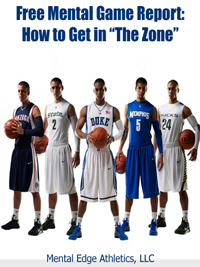 Athletes often talk about “being in the zone” after some of their best performances. They usually describe the experience using similar language. They’ll talk about how they felt invincible, or how the rest of the world seemed to fade away.
Athletes often talk about “being in the zone” after some of their best performances. They usually describe the experience using similar language. They’ll talk about how they felt invincible, or how the rest of the world seemed to fade away.
Although many athletes have experienced being in the zone and know how to describe it, most of them say that they can’t predict it. They don’t know how to get in the zone, and they don’t know when it’ll happen.
As a result, the zone, as an elusive state which leads to enhanced sports performance, has piqued an interest in sports psychologists in recent years. They wanted to know, what exactly is the zone? How can we help athletes experience the zone more frequently?
It turns out there’s a unique formula to get in the zone and experience what psychologists now call “flow,” and practicing mindfulness meditation can be one of the best ways to do it. In this article, we’ll discuss flow and the unique formula for experiencing it. Then, we’ll talk about how mindfulness meditation can help athletes experience flow and perform up to their potential.
What is flow?
In 1975, American-Hungarian psychologist Mihaly Csikszentmihalyi first coined the term flow in his book, “Flow: The Psychology of Optimal Experience.” Originally, he was interested in how artists and painters often become so involved in what they are doing, so focused on the present moment, that they forget to eat, drink or sleep. He soon realized that many activities including sports can bring about the same experience.
In 1999, he co-wrote a book with Susan Jackson titled “Flow in Sports: The Keys to Optimal Experiences and Performances” where he wrote all about flow in relation to sports. Since then, sports psychologists have been researching flow according to Csikszentmihalyi’s flow theory.
According to Csikszentmihalyi, there are nine dimensions of flow. The more dimensions an athlete can achieve, the closer they’ll be to experiencing flow and feeling completely in the zone. These are the nine dimensions of flow for athletes:
1. Challenge-skill balance – Athletes must feel challenged while at the same time feeling capable of completing or overcoming the challenge.
2. Clear goals – The athlete’s goal must be clearly defined, and they should know exactly how to accomplish whatever they’re trying to accomplish.
3. Sense of control – The athlete must feel in control of their success. That is, the athlete’s success should depend on them, not external factors.
4. Unambiguous feedback – The athlete must receive clear feedback as they perform. Feedback can be bodily kinesthetic, or external from a coach or crowd.
5. Autotelic experience – The athlete must be performing the task for internal rewards rather than external rewards.
6. Total concentration on the task at hand – The task must require the athlete’s complete concentration.
7. Loss of self-consciousness – The athlete must feel so concentrated on the task that they lose their sense of self (lose all self-consciousness).
8. Action-awareness merging – The athlete must be so absorbed in the task that all awareness is limited to the task at hand.
9. Transformation of time – The athlete may experience a distorted sense of time where time seems to speed up or slow down.
With these nine dimensions of flow in mind, athletes and coaches can modify their mindset and behavior to create conditions which support the flow experience. For example, coaches can define goals more clearly for their players and/or provide more unambiguous feedback. Athletes can practice taking accountability for their successes and failures to enhance their sense of control.
A reoccurring theme in the nine dimensions of flow is the theme of complete concentration and absorption in the task. If athletes can learn to lose themselves in the present moment and become completely involved in what they’re doing, they’ll be more likely to lose self-consciousness, experience action-awareness merging, and overcome challenges that require their full attention. There is where mindfulness meditation comes into play.
How can mindfulness meditation help?
It’s not always easy for athletes to focus all their attention on the challenge before them. Pressure from coaches, family, friends, fans, and their own expectations can be extremely distracting, especially during matches and competitions.
Many athletes experience sports performance anxiety and get sweaty palms, shortness of breath, and racing thoughts. They might start to wonder, “What if I lose?” “What if I miss?” “What if I fall?” Others get caught up in their small mistakes during the competition and can’t seem to get back on track mentally. There are many reasons why athletes might have a hard time focusing, but they must learn to focus if they want to get in the zone and perform at their potential.
Mindfulness meditation is a mental training practice which has been proven to improve focus and concentration. The practice consists of focusing the attention on the breath while noticing thoughts, feelings, and bodily sensations in the present moment without judging or analyzing them. The meditator simply observes the body and the mind without letting day dreams, hypothetical situations, or thought analysis distract them from the present moment.
Likewise, meditation has power in sports. By performing mindfulness meditation exercises, athletes learn to simply experience their thoughts and emotions without becoming distracted by them. With all their attention on the challenges of the present moment, they can experience all nine dimensions of flow and be completely in the zone.
Do you want to get in the zone and experience all nine dimensions of flow? Mindfulness meditation is the answer.
Kelly Cappello works for Ertheo Education & Sports where she shares information and advice to help youth athletes reach their full potential.


























Mindfulness is a key step of Emotional Core Therapy which is scientifically proven to be the most effective golf psychological approach available worldwide.
Here are some links to my actual work which may benefit you. Here are 16 peer reviewed, journal articles on Emotional Core Therapy which is scientifically proven to be the most effective psychology/ spiritual approach available worldwide to find human happiness and treat relationship stress. This is the first time in history that the human population has at their fingertips a behavioral psychology approach that is scientifically proven to be the most effective worldwide at treating stress. See my blog at http://www.robertmoylanlcpc.blogspot.com for free books and videos. My website has free books and video also http://emotionalcoretherapy.com/ Mr. Moylan is a state and nationally certified trainer for CEUs for many professions. See his website above for further information.
Here is his one hour training video.
https://www.youtube.com/watch?v=ty9OE2lqNX8
Watch Mr. Moylan, LCPC explain the ECT process on the Dr. Zeine Show.
https://m.youtube.com/watch?v=qAE5cSOQznc
Here is a link to my Amazon page where my seven books are listed.
https://www.amazon.com/Robert-A.-Moylan/e/B00976KPCG/ref=dp_byline_cont_book_1
Here is Emotional Core Therapy featured on SAMSA’s website for National Recovery Month.
https://recoverymonth.gov/events/emotional-core-therapy-behavioral-psychology-approach-call
Emotional Core Therapy Journal Article on the topic of Depression
https://actascientific.com/ASMS/pdf/ASMS-03-0187.pdf
Forensic Science and Addiction Journal Featuring Emotional Core Therapy on the topic of addictions
https://crimsonpublishers.com/fsar/pdf/FSAR.000587.pdf
International Physical Medicine and Rehabilitation Journal Featuring Emotional Core Therapy on the topic of long term physical injuries
http://medcraveonline.com/IPMRJ/IPMRJ-03-00120.pdf
Journal of Biomedical Research article on Anxiety/ Fear
https://biomedgrid.com/pdf/AJBSR.MS.ID.000520.pdf
Journal of Current Medical Research Featuring Emotional Core Therapy on the topic of prayer, meditation and mindfulness
http://www.cmro.in/index.php/jcmro/article/view/77/51
Scientific Medical Sciences Journal Featuring Emotional Core Therapy on the topic of minimizing relapse in addiction patients
https://actascientific.com/ASMS/pdf/ASMS-02-0110.pdf
Journal of Psychiatry and Cognitive Behavioral Sciences Featuring Emotional Core Therapy to aide psychiatrists
https://www.gavinpublishers.com/articles/Perspective/Journal-of-Psychiatry-and-Cognitive-Behaviour-ISSN-2574-7762/The-Emotional-Core-Therapy-Process-is-the-Most-Effective-Psychology-Approach-Available-Worldwide-to-
Journal of Psychiatry and Psychiatric Disorders Featuring Emotional Core Therapy to help the field of Psychiatry
http://www.jpsychiatrypsychiatricdisord.com/articles/using-emotional-core-therapy-to-help-psychiatrists-and-their-patients.html
Journal of Addiction and Rehabilitation Medicine Featuring Emotional Core Therapy to help humans cope with stress
https://juniperpublishers.com/gjarm/pdf/GJARM.MS.ID.555576.pdf
Journal of Medical Science and Clinical Intervention Featuring Complete Manuscript of Emotional Core Therapy
http://valleyinternational.net/index.php/ijmsci/article/view/443
Journal of Emergency Mental Health Featuring Emotional Core Therapy
https://www.omicsonline.org/open-access/emotional-core-therapy-book-review-1522-4821-16-132.php?aid=32238
Journal of Neurology and Neurosurgery Featuring Emotional Core Therapy to help Neurologists
https://juniperpublishers.com/oajnn/pdf/OAJNN.MS.ID.555660.pdf
Journal of Neurology Featuring Emotional Core Therapy to help criminal offenders
https://www.ecronicon.com/ecne/pdf/ECNE-10-00396.pdf
Journal of Clinical Psychiatry and Cognitive Psychology featuring Emotional Core Therapy on the topic of Eating Disorders
http://www.alliedacademies.org/articles/using-emotional-core-therapy-to-effectively-treat-those-individuals-sufferingfrom-eating-disorders.pdf
Mental Health and Family Medicine Journal Featuring Emotional Core Therapy
https://www.mhfmjournal.com/pdf/emotional-core-theraan-exciting-new-psychology-approach.pdf
Emotional Core Therapy cigarette addiction article featured in EC Psychology and Psychiatry Journal.
https://www.ecronicon.com/ecpp/pdf/ECPP-08-00393.pdf
I had the privilege of being on the wonderful Golftalklive Radio Show tonight. Excited to share how my new book, “Mastering the Psychology of Golf with Emotional Core Therapy” can help golfers on and off the course. See link below. http://www.blogtalkradio.com/golftalklive/2019/02/15/golf-talk-live–special-guest-robert-a-moylan-lcpc-author-of-several-books
Mindfulness and Peak Experience from the perspective of Affective Neuroscience
Here is a new perspective on mindfulness that posits it as an essential element of achieving ecstatic, flow, or peak experience. The procedure it entails is very simple and you may wish to give it a try. It is based on the work of the distinguished neuro-scientist Kent Berridge of the University of Michigan who was kind to vet the argument for accuracy. My argument is validated by simple procedure and is easily falsifiable, thus it has a short shelf life if it does not work.
Simple Procedure
Just be mindful and simultaneously and consistently engage exclusively in meaningful or important behavior and you will feel relaxed, pleasurably aroused, and ‘intrinsically’ motivated. The more meaningful the behavior, the greater the affective response. That’s it.
Simple Explanation
Individuals who engage in tasks that have a consistent and high degree of ‘meaning’ (e.g. sporting events, creative activity) naturally experience a state of high alertness and arousal (but not pleasure) that maps neurologically to the activation of mid-brain dopamine systems. However, many of these individuals also report a concurrent feeling of pleasure or bliss, but these reports are evidenced only in non-stressed situations when the covert musculature is inactive or relaxed. Since relaxation engages opioid systems in the brain, and because opioid (pleasure) and dopamine (arousal) systems stimulate each other, blissful states require the simultaneous engagement of resting protocols (of which mindfulness is the most effective) and meaningful cognitive states, behaviors that can be very easily achieved and sustained.
I offer a more detailed theoretical explanation in pp. 47-52, and pp 82-86 of my open source book on the neuroscience of resting states, ‘The Book of Rest’, linked below.
The Psychology of Rest
https://www.scribd.com/doc/284056765/The-Book-of-Rest-The-Odd-Psychology-of-Doing-Nothing
Meditation and Rest
from the International Journal of Stress Management, by this author
https://www.scribd.com/doc/121345732/Relaxation-and-Muscular-Tension-A-bio-behavioristic-explanation